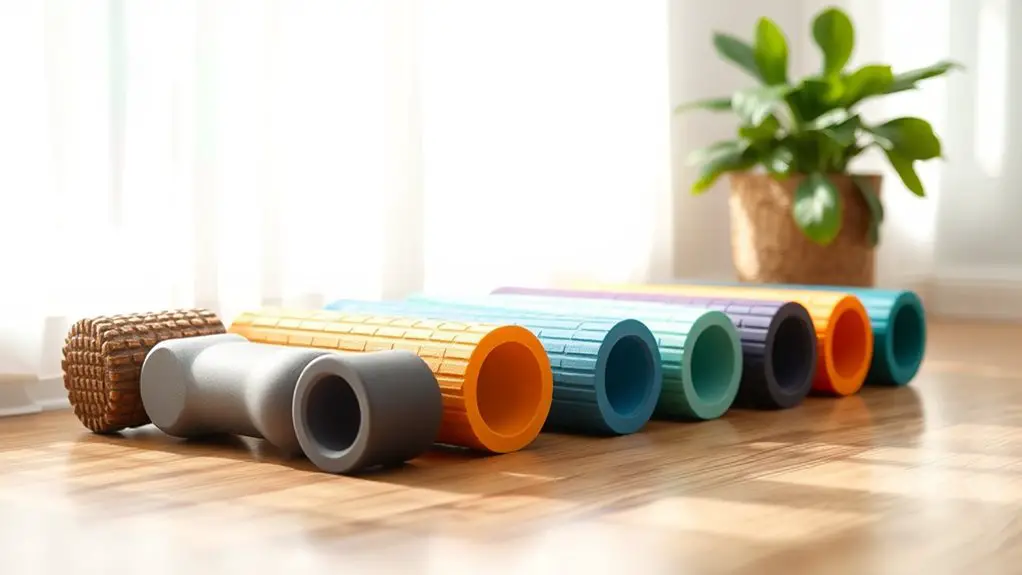Shoulder stability is essential for pitchers because it directly impacts your performance and reduces injury risks. A stable shoulder allows for efficient arm motion, enhances pitching mechanics, and helps maintain proper alignment during throws. With strong shoulder support, you can throw faster and more accurately while minimizing stress. This stability is linked to well-executed movements and proper conditioning. You'll find more insights on how to enhance your shoulder stability and keep your pitching career thriving.
Understanding Shoulder Anatomy and Function
The shoulder is a complex joint essential for a pitcher's performance. Understanding shoulder biomechanics is key to revealing your potential on the mound. At the heart of this intricate system is the rotator cuff, a group of muscles and tendons that stabilize and allow movement in your shoulder. When you pitch, your shoulder undergoes a dynamic range of motions, from wind-up to follow-through.
If you grasp how the rotator cuff works in harmony with other shoulder structures, you can enhance your pitching mechanics and reduce the risk of injuries. This knowledge empowers you to make informed decisions about your training and recovery. By focusing on strengthening and maintaining the rotator cuff, you'll improve your shoulder's function, leading to better performance. Remember, the more you understand your shoulder's anatomy, the freer you'll feel to express your unique pitching style without the fear of injury holding you back. Additionally, incorporating key exercises for rotator cuff strengthening into your routine can significantly enhance shoulder stability and performance.
The Importance of Shoulder Stability in Pitching
Shoulder stability is essential for every pitcher, as it directly impacts your performance and helps prevent injuries. By understanding the mechanics involved and incorporating strengthening exercises, you can enhance your pitching technique. Let's explore how focusing on shoulder stability can make a significant difference in your game. Core strength acts as the foundation of athletic performance, providing the stability needed for effective pitching movements.
Injury Prevention Techniques
While it may seem like a minor aspect of pitching, shoulder stability plays an essential role in preventing injuries. To maintain that stability, you should incorporate dynamic warm ups into your routine. These exercises prepare your muscles and joints, reducing the risk of strains or tears. Don't underestimate the power of proper hydration, either; staying well-hydrated keeps your muscles functioning efficiently, which is vital during long practices or games. Additionally, focus on strengthening your rotator cuff and scapular muscles through targeted exercises. This not only enhances stability but also helps you avoid overuse injuries. By prioritizing these injury prevention techniques, you're setting yourself up for a healthier, more successful pitching career. Embrace the freedom that comes with being injury-free!
Mechanics and Performance
Incorporating effective injury prevention techniques lays the groundwork for understanding how shoulder stability directly impacts pitching mechanics and performance. When you focus on your shoulder's stability, you're not just preventing injuries; you're enhancing your pitching techniques. A strong, stable shoulder allows for smoother, more efficient arm motion, which is essential for peak performance. Through biomechanics analysis, you can pinpoint how each movement affects your pitch. This insight helps you refine your mechanics, ensuring that every throw maximizes speed and accuracy while reducing strain. Emphasizing shoulder stability empowers you to release your full potential on the mound, giving you the freedom to pitch with confidence and finesse. Remember, a stable shoulder is the key to elevating your game.
Strengthening Exercises Recommended
To guarantee ideal shoulder stability during pitching, integrating targeted strengthening exercises into your routine is essential. These exercises not only enhance your performance but also give you the freedom to pitch confidently. Consider incorporating band exercises, resistance training, and mobility drills to boost your shoulder strength. Stability balls can improve core stability, while dumbbell routines add power to your throws. Proprioceptive training with shoulder bands will enhance your body awareness, ensuring you're always in control.
| Exercise Type | Benefits |
|---|---|
| Band Exercises | Improves shoulder stability |
| Resistance Training | Builds strength |
| Core Stability Drills | Enhances balance |
| Mobility Drills | Increases range of motion |
| Dumbbell Routines | Adds pitching power |
Stay committed, and your shoulder will thank you!
How Shoulder Instability Affects Performance
When a pitcher experiences shoulder instability, it can greatly hinder their performance on the mound. You might notice a decline in your velocity and accuracy, as shoulder biomechanics become compromised. When your shoulder isn't stable, the entire kinetic chain is affected, which can lead to suboptimal mechanics. This means you may struggle to generate the same power and control you once had.
Performance metrics, like pitch speed and strike percentage, can take a hit, making it difficult to compete at your best. You might find yourself overcompensating with other muscles, increasing the risk of fatigue and injury. Plus, every pitch becomes a gamble, as you can't trust your shoulder to deliver the precision you need. Ultimately, shoulder instability can limit your ability to showcase your talent, leaving you longing for the freedom to play without worry. Prioritizing stability is essential for reclaiming your performance. Additionally, strengthening exercises for knee stability can also benefit shoulder mechanics by improving overall body control.
Common Injuries Linked to Shoulder Instability
When you experience shoulder instability, it can lead to serious injuries like rotator cuff tears and shoulder impingement syndrome. These conditions not only hurt your performance but can also sideline you for an extended period. Understanding these risks is essential for maintaining your shoulder health as a pitcher. Implementing proper warm-ups and dynamic stretches can help prevent these injuries and enhance shoulder stability.
Rotator Cuff Tears
Although rotator cuff tears can occur in anyone, they're particularly prevalent among pitchers due to the repetitive overhead motions involved in their sport. Each throw puts immense stress on your shoulder, increasing your injury risk. When you push your limits, the rotator cuff muscles can weaken, leading to tears that may sideline you for the season. Recognizing the importance of shoulder stability isn't just about performance; it's about preserving your freedom to play without pain. Strengthening your rotator cuff through targeted exercises can help mitigate this risk and keep you in the game. Don't let an injury dictate your passion. Prioritize your shoulder health, and you'll enjoy the thrill of pitching while minimizing those nagging setbacks.
Shoulder Impingement Syndrome
Shoulder impingement syndrome often arises from shoulder instability, making it a common concern for pitchers. When your shoulder joint isn't stable, the structures surrounding it can become pinched during throwing motions, leading to shoulder pain that limits your performance. You might feel discomfort when reaching overhead or during your pitch, hindering your freedom on the mound. Fortunately, there are effective rehabilitation techniques to help you regain stability and strength. These may include targeted exercises to improve your rotator cuff and scapular muscles, along with stretching to enhance flexibility. By addressing shoulder impingement syndrome early, you can prevent further injury and keep your pitching career on track, allowing you to enjoy the game without limitations.
The Role of Strength and Conditioning in Shoulder Stability
While many factors contribute to shoulder stability in pitchers, strength and conditioning play an essential role in supporting the joint's integrity and function. By focusing on these elements, you can enhance your performance and reduce injury risk.
Consider these key aspects of strength and conditioning:
- Core Stability: A strong core stabilizes your entire body, allowing for better control during pitches and reducing shoulder strain.
- Dynamic Stretching: Incorporating dynamic stretching routines warms up your muscles, improving flexibility and range of motion, which are crucial for effective pitching mechanics.
- Targeted Strength Training: Building strength in the rotator cuff and surrounding muscles helps maintain joint stability, providing a solid foundation for powerful throws. Additionally, shoulder strength is vital for performance and injury prevention in athletes like pitchers.
Exercises to Enhance Shoulder Stability
To enhance shoulder stability, incorporating specific exercises into your training routine is essential. Focusing on band exercises and stability drills can make a significant difference. These exercises not only strengthen the muscles around your shoulder but also improve coordination and control. Additionally, maintaining proper flexibility is crucial for preventing injuries and optimizing performance.
Here's a simple table to get you started:
| Exercise | Description |
|---|---|
| Band External Rot. | Attach a band and rotate away. |
| Band Internal Rot. | Rotate towards your body. |
| Scapular Push-ups | Engage shoulder blades while pushing up. |
| Plank with Rotation | Rotate your torso while holding a plank. |
| Single-arm Rows | Strengthen back and shoulder stability. |
The Impact of Mechanics on Shoulder Health
Proper mechanics play an essential role in maintaining shoulder health, as a slight misalignment can lead to significant injuries over time. When you pitch, focusing on mechanical efficiency not only enhances your performance but also protects your shoulder. Think about these three key factors:
Proper mechanics are vital for shoulder health; even minor misalignments can lead to serious injuries over time.
- Arm Path: A smooth, natural arm path minimizes stress on the shoulder.
- Follow-Through: An effective follow-through guarantees that force is distributed evenly, reducing strain.
- Body Alignment: Proper body alignment keeps your shoulder in a safe position throughout the pitching motion.
Recovery Strategies for Shoulder Injuries
Even with the best mechanics, shoulder injuries can still occur, making recovery strategies vital for pitchers. To regain your strength and mobility, focus on effective rehabilitation techniques tailored to your specific needs. Start with gentle range-of-motion exercises to reduce stiffness, then progress to strength-building routines as your shoulder heals.
Injury management is important, so listen to your body and don't rush the process. Ice therapy can help reduce inflammation, while compression and elevation support recovery. Incorporating physical therapy sessions can provide expert guidance and guarantee you're on the right path. Proper nutrition plays a significant role in supporting muscle recovery, so ensure you're fueling your body with the right nutrients.
Don't overlook the importance of rest; it's your body's way of healing. Once you're ready, gradually ease back into your pitching routine, making sure you maintain proper form to prevent future injuries. Remember, taking the time for recovery now means greater freedom on the mound later.
Long-Term Benefits of Maintaining Shoulder Stability
While shoulder injuries can sideline pitchers, maintaining shoulder stability offers long-term benefits that extend beyond immediate recovery. You'll not only enhance your performance but also enjoy a more fulfilling, injury-free career. Here are three key advantages you can look forward to:
- Improved Long-Term Performance: A stable shoulder supports consistent pitching mechanics, allowing you to throw with power and precision.
- Reduced Risk of Future Injuries: Strengthening your shoulder's stability minimizes the chances of re-injury during the rehabilitation process and beyond.
- Greater Longevity in Your Career: With a strong foundation, you can continue to pitch at a high level well into your later years.
Frequently Asked Questions
How Can I Tell if My Shoulder Is Unstable?
Did you know that nearly 25% of shoulder injuries stem from instability? To tell if your shoulder's unstable, consider a shoulder assessment. You might notice pain during certain movements or a feeling of looseness. Stability tests, like the sulcus sign or apprehension test, can reveal issues too. If you find yourself hesitating during activities you love, it's time to consult a professional. Don't let shoulder problems hold you back from your freedom!
Can Shoulder Stability Improve My Pitching Velocity?
Yes, shoulder stability can definitely improve your pitching velocity. When your shoulder's stable, it enhances your pitching mechanics, allowing for smoother, more efficient movements. This stability promotes better muscle coordination, which means your body can generate more power with each pitch. You'll find that with a strong and stable shoulder, you can release your full potential on the mound, giving you the freedom to express your pitching style without hesitation.
What Are the Signs of a Shoulder Injury While Pitching?
When you're pitching, keep an eye out for signs of a shoulder injury. If you start feeling shoulder pain, especially during your delivery, it could indicate an issue. You might notice changes in your pitching mechanics, like decreased velocity or struggling to control your pitches. Don't ignore these symptoms; they can lead to more serious problems down the line. Staying aware of your body helps you maintain your freedom on the mound.
How Often Should I Perform Shoulder Stability Exercises?
Imagine your shoulder as a well-oiled machine, ready to release power with every pitch. To keep it running smoothly, aim for shoulder stability exercises two to three times a week. This frequency allows your muscles to strengthen without overdoing it. Incorporate various exercise variations—like resistance bands and stability balls—to keep things fresh and engaging. By prioritizing this routine, you'll feel more confident and free on the mound, minimizing injury risks.
Are There Specific Warm-Up Routines for Shoulder Stability?
Absolutely, there are specific warm-up routines you can follow for shoulder stability. Start with dynamic shoulder exercises like arm circles and wall slides to get the blood flowing. Then, incorporate stability drills such as resistance band external rotations and scapular push-ups. These will help strengthen your shoulder muscles while enhancing stability. You'll feel more confident and ready to move freely, allowing you to perform at your best without the worry of injury.




